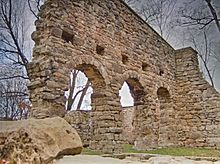Cyriakskirche (Camburg)
Coordinates: 51 ° 3 ′ 48.8 ″ N , 11 ° 41 ′ 41 ″ E
The Cyriac church to Camburg (City Dornburg-Camburg ) is, according to some historians next to the St. Michael's Church (pipe) the only from the time obtained until about 1030 buildings in Thuringia . Others see it as a typical Romanesque church. It is also called St. Cyriakus , Cyriaksburg or Cyriaksruine. Considering its importance for the country, the building is little known.
description
The ruin of the church is located 1.5 km northwest of the small town of Camburg in the Saale-Holzland district in Thuringia in the so-called Stöbener Holz.
A 3D parcour for traditional archery is laid out around the ruins.
history
In a note in the chronicle of Thietmar von Merseburg for the period 996–1002 :
- “De quorum numero quaedam cometissa nomine Cristina predii suimet, quod in Stuwi civitate habuit, magnam partem sancto tradidit Maurico in Magadaburg.” (Among them was a Countess Christina, who donated a large part of her inheritance in Stöben Castle to Saint Mauritius in Magdeburg .)
The castle mentioned in the chronicle can no longer be traced today. From said Moritz Monastery in Magdeburg from the foundation was the Augustinians - Canons Neuwerk near Halle .
In 1121 a papal confirmation document certified that the "Church of Stubi" belonged to the Augustinian canons of Neuwerk / Saale.
According to research by Wolfgang Hartmann , the woman who was buried in front of the altar of the church is Adelheid, the wife of Count Dietmar von Selbold-Gelnhausen . Dietmar came from the noble family of Reginbodonen and was allegedly related by marriage to Count Wilhelm von Camburg. A daughter of Dietmar and Adelheid is said to be Kuniza, the founder of the Lausnitz monastery . She built a hermitage near her estate "Rysen" (Wüstung Reißen, near Eckolstädt ) . This could have been in the immediate vicinity of the church ruin, which is now referred to as the Cyriakskirche. At least Stöben Castle, which had come into the possession of Dietmar, is probably related to this hermitage.
The church was a parish church until 1539. In the High Middle Ages , similar to Rodameuschel , the newly created parish Camburg was spun off from the parish "mons St. Cyriaci".
The church was abandoned after 1539 because it was in the course of the Reformation to merge the parishes "Camburg", mons "St. Cyriaki "and mons" St. Petri “came. Since then, it has served as a quarry for the surrounding villages, where church stones can still be found today.
In the 1930s, excavations took place in the area around the church, during which skeletons were also uncovered.
In the GDR, the Kulturbund Camburg took care of the maintenance of the complex, which was a popular excursion destination.
Recently, a renovation has been carried out in connection with the removal of wild trees and undergrowth. In the course of the renovation of the altar, it was consecrated so that church services are held on the site in summer. Every two years, a large archery tournament with medieval spectacles, the Cyriakus Festival, takes place in and around the ruins on the site.
construction
The hall church consists of a nave , to which a strongly recessed priest room ( presbytery ) and a rectangular chancel adjoin. Four arcades each separated two side rooms from the priestly room, of which only three arcades from the southern row of arches have survived. In this one can see beam holes that indicate the low roof height of the side rooms. This architecture: hall church, rectangular choir and side priestly rooms shows Romanesque, but regionally unusual construction methods reminiscent of Byzantine models. This also led to the controversial thesis that Ottonian components could be identified that create a connection to the Civitas Stuw (b) i, which is documented in 999.
On the southern front, a small window, a slit of light that tapers outwards, has been preserved in its original form.
Two underground passages lead from the facility, but they have now been buried. One can still be walked a few meters, originally said to have reached the village of Camburg . Here it is said to have ended on the church square next to the rectory. The second passage allegedly led under the Saale to the village of Abtlöbnitz . These legendary claims are very improbable because of the lack of a historical context and because of the geological conditions.
Modern times
The first archaeological investigation took place in 1885 . At this point and later, some restoration work was carried out.
The ruins of the church were often used as a playground by children from Camburg, which caused further damage, such as the destruction of the altar stone . It was not until the 1970s that the value of this facility was recognized and maintenance measures were attempted.
literature
- Annett Laube-Rosenpflanzer, Lutz Rosenpflanzer: churches, monasteries, royal courts. Pre-Romanesque architecture between the Weser and Elbe. Mitteldeutscher Verlag, Halle 2007, ISBN 978-3-89812-499-7 .
- Wolfgang Hartmann: From the Main to Trifels Castle - from Hirsau Monastery to Naumburg Cathedral. On the traces of the Franconian aristocratic family of the Reginbodonen from the High Middle Ages = publications by the Aschaffenburg History and Art Association, Vol. 52, Aschaffenburg 2004, ISSN 0433-843X
- Thuringia, arr. v. Stephanie Eißing, Franz Jäger u. a., ed. in cooperation with the Thuringian State Office for Monument Preservation, 2003 2 , pp. 184–185.
Web links
Individual evidence
- ↑ Camburg archery course. Camburger Bogenschützen eV, accessed on February 12, 2020 .
- ^ Andrei Zahn: Was there a monastery on the Cyriaksberg near Camburg? Investigations on the parishes of St. Cyriaksberg and St. Petersberg near Camburg, in: Contributions to the early history and the Middle Ages of East Thuringia, in preparation.
- ↑ http://dornburg-camburg.de/ortschaften/camburg/die-cyriaksruine/
- ↑ Saint Cyriacus. In: arch INFORM ; accessed on April 29, 2015. (floor plan)


